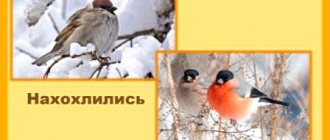Martin Root "Cosmos" (Clever Publishing, 2016)
mamsila.ru
This book will be understandable and interesting even for children 3-4 years old; it may well become the first encyclopedia about space in your children's library. The author talks in an accessible way about the planets of the solar system, the Sun, the Moon, stars and galaxies.
You can play with the book: the pages have opening flaps that little explorers love to look under. By opening such a valve, children will see what is inside the spacesuit, how the rocket works, and what the Earth is made of.
G. N. Elkin “For children about space and astronauts”
www.ozon.ru
The book introduces you to the wonderful world of space. Written in accessible language and well illustrated. It will be useful for children, their parents and teachers working with children.
The young reader will learn what stars and black holes are, where comets and asteroids come from, what cosmic dust is made of, what galaxies and constellations are, what the planets and their satellites are called, how the solar system works, who invented rockets, spacecraft and how they work cosmodromes. The author talks about astronauts and their heroic profession, who was the first to fly into space and how people visited the Moon.
Efrem Levitan “To kids about stars and planets” (“Rosman”)
mamsila.ru
This book is a bestseller that has collected a huge number of rave reviews; its author is Efim Devitan, a famous popularizer of astronomy. Perfect for children aged 4 years and older to explore space for the first time.
This astronomical tale tells kids about the Universe in an accessible and fun way. Visual illustrations and simple experiments help parents explain complex phenomena using simple examples.
E. Kachur “Fascinating astronomy”
www.babyblog.ru
A beautiful, bright and educational book from a series of encyclopedias with Chevostik. Together with the inquisitive hero, little readers will go to the observatory to see planets, stars, comets and much more through the telescope.
Why does the Moon sometimes look like a sickle, and sometimes even round? How to distinguish a planet from a star? What is a light year and why is one Earth year equal to four Mercury years? Which planet is the smallest and which is the largest? Do stars appear during the day? Why is the comet tailed? What is orbit and satellite, meteors and eclipse? You will find answers to these and other questions in the book. Simple texts, cute illustrations, detailed diagrams and experiments will help readers fall in love with space.
Great Children's Encyclopedia Translation from English by T. Pokidaeva
Any quick question from a child’s lips will not sound scary, because this encyclopedia has everything to answer what the Universe and the Milky Way are, how many stars are in the sky and why they twinkle, which stars can explode and whether the Sun will die. Part of the book is dedicated to space.
The book is not overloaded with texts that are difficult for a child to understand; the illustrations are bright and clearly demonstrate phenomena that can be difficult to explain in accessible language.
Space and earth. A unique illustrated encyclopedia for children
knigamir.com
With the help of this book, children will make an exciting journey to different parts of the world on our planet; They will visit the mountains, walk through cities and plains, and even fly into space! By reading the book "Space and Earth", they will learn how to observe the night sky, use binoculars and a telescope, and how an astrological observatory works. Tips from experienced travelers will help you learn to read maps and build routes, navigate the terrain, use a compass and notice the clues of nature. Suitable for children of primary school age.
Encyclopedia for the curious “Why and Why”. Translation from English by T. Pokidaeva
This book has a section on time and seasons. Important concepts are explained clearly and in accessible words. The book is intended for reading by adults to children, it can be used for preschoolers.
Why does the sun rise and set? Why is it dark at night? What is a leap year and why do we need a calendar? What time is it in space?
The great advantages are high-quality illustrations, good paper and binding.
Trilogy by Efrem Levitan “Fairytale Universe” (“Meshcheryakov Publishing House”)
mamsila.ru
The trilogy includes the books: “Secrets of Our Sun”, “The Kingdom of the Sun”, “The World in which the Stars Live”.
The main characters are the author's own children - Alka and Sveta, as well as the gnomes Knopkin and Nedouchkin. Every evening, dad tells the children fairy tales about space, about how our Universe works, about the Sun, the Moon, what gravity is, what planets of the solar system exist. Material that is difficult for children to understand is presented in an accessible and engaging way. The experiments that dad conducts with children on the pages of books can be repeated at home with the child.
O. I. Sumatokhina “Space. 3D encyclopedia"
What invisible secrets does the cosmos hide?
The encyclopedia will help young children discover the Universe, meet famous astronauts, understand how a telescope works and what space stations are needed for.
3D imaging technology (glasses) will help bring the unknown closer.
The book contains a large number of photographs, the text is presented in small blocks.
IN AND. Tsvetkov “Starry sky. Galaxies, constellations, meteorites"
The popular scientific and practical encyclopedia will tell young readers about the ancient science of astronomy, teach them how to “read” a star map, and introduce them to the names of the brightest stars.
Readers will learn where to look for the “heart of a lion” and “Beronica’s hair,” what the “great summer triangle” is, what connects the word “vacation” and the brightest star in the sky - Sirius. Where are observatories built and why the room where the telescope is located cannot be heated, how Stonehenge helps you find out the cardinal directions, where is the best place to observe the stars and much more.
Hard cover, high-quality printing, many photographs and drawings, diagrams. The text is adapted for independent reading by school-age children; the information can be trusted, because The reviewer was Doctor of Physical and Mathematical Sciences, Professor.







